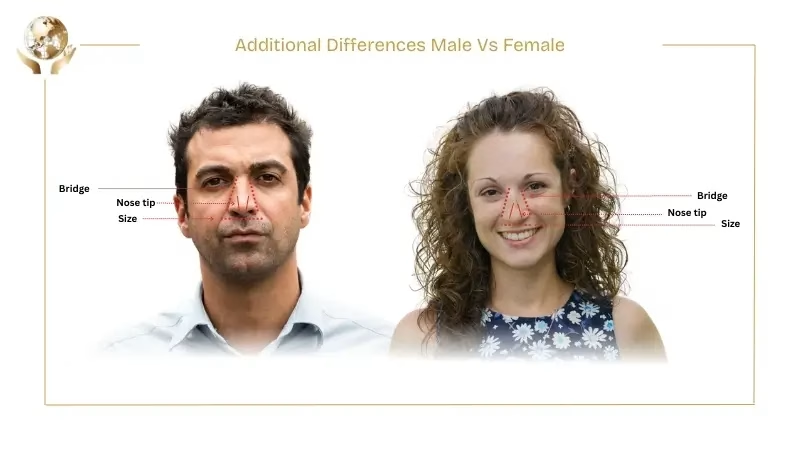Male Vs Female Nose Rhinoplasty – Differences You Must Know
Gender doesn’t change the rhinoplasty so much. The techniques involving the incisions, anesthetics, and cartilage remain the same. But still, there are some differences between male vs female noses that shape the process a little.
Some are anatomical, like the shape, thickness of the cartilage and the bone, and also the softness. While some are psychological, including different expectations and aesthetic goals about the rhinoplasty.
Male Vs Female Nose Rhinoplasty: What Are The Differences?
There are a few differences in feminine vs masculine noses that we take into account while performing rhinoplasty. The idea is to give both the look they deserve and keep their identity intact.

Anatomical Differences
Men typically have larger, more prominent noses with wider nostrils and denser bone structure. Their skin is also quite thick, which delays the recovery from the surgery. Their nose sticks out more from the surface of the face compared to females.
In males, the nose typically forms a fairly straight angle with the upper lip, measuring about 90 to 95 degrees when viewed from the side.
Females have a delicate nose with soft bones and cartilage. It’s smaller and less strong compared to that of a man.
Their nose looks more elevated, as the angle from the upper lip to the female nose is 10 degrees more than in males. Furthermore, the noses of women are also finer. Hence, they smoothly lay on the nasal structure, giving the nose a more defined appearance.
See Also: Famous Celebrities Noses
Difference Of Goals For Rhinoplasty
Both genders have different goals that they want to achieve with rhinoplasty. Men usually get this surgery when their nose gets misshapen due to an accident during sports or while driving. They like getting a sharper, stronger, and straighter nose with larger nostrils and a higher bridge.
Contrarily, women are quite specific about what they want and quite cautious about how the nose will complement their facial features. They like a petite nose with upward tip rotation, but not so much that it looks bad or creates a slope-like appearance.
They want a proportional nose size, neither too big nor too small, refined, unlike men who are more focused on a stronger and straighter nose.
See Also: Button Nose Shape
Surgical Techniques For Rhinoplasty
Every rhinoplasty technique is carefully designed to meet the requirements of the patient while ensuring that they look exactly as they are.
Male
Precise techniques are used to correct the shape, size, and definition of the nose. The surgeons ensure that they preserve the masculine characteristics of the nose.
When the size of the nose is decreased, it’s ensured that it’s not overdone to prevent the nose from looking feminine.
Men like the prominent and more defined nose, because of which the augmentation technique is used in male rhinoplasty.
Female
Surgeons focus on refining the nose while keeping its softness intact. Subtle changes like bridging the gap, reducing the nasal hump, and refining the nose tip are made to give a sharper, naturally defined appearance.
The idea is always to create a nose that complements the facial features, as it’s typically what woman chooses.
See Also: Finesse Rhinoplasty
Recovery From The Surgery
Due to the thicker skin, stronger cartilage, and bone, the swelling and bruising take time for men to heal. They may take a few weeks to get rid of these and a few extra months to fully heal compared to women.
Women, on the other hand, tend to have supple nasal structures and thinner skin, which allows for quicker recovery. Their full recovery time is faster than men’s due to their naturally graceful skin that heals faster.

Results
There isn’t so much of a difference in the results that males and females get. They’re permanent and appear just after some time following the surgery, when the healing begins. The full results come in over a year.
Psychological Differences
Women often undergo rhinoplasty to align with societal fashion trends, meet beauty standards, and attain a desired self-image.
While men get it when they feel that their mismatched, or too big or small, nose is taking away their attractiveness and confidence. Sometimes, they do it because of the influence of their professional life.
Risks
Since rhinoplasty is a complex surgery that involves modifying your nose, there are some risks associated with it. These include infections, scarring, and breathing difficulty. So, regardless of your gender, you must follow the post-care tips to get a safe recovery.
Additional Differences Male Vs Female
We’ve found these masculine vs feminine nose differences to be common.

- Women’s bridge has a slight natural curve
- The male nose tip is rounder and broader
- The female tip looks sharper and more refined
- The nose tip should sit in a neutral, straight position
- Thicker skin in men makes reshaping harder

Best Surgeon For Male Vs Female Nose Rhinoplasty
Whether you’re a man or a woman, you need to look for surgeons who are experienced with both genders. They must have performed surgeries on both men and women so that they can use tailored techniques to give you the desired results safely while keeping your identity intact.
That’s what we do at Asli Tarcan Clinic, a top-class rhinoplasty clinic in Turkey with certified plastic surgeons experienced in male and female rhinoplasty.
They conduct your medical tests, understand your goals and concerns, and then create a customized rhinoplasty plan that suits you best and delivers the results you want.
Final Words
Male vs female nose: what are the differences in rhinoplasty? There are some anatomical and psychological differences between the two. Men usually want to keep a bold, structured look. Women often lean toward something more refined and subtle. Healing tends to be slower for men because of thicker skin.
Still, in both cases, the goal isn’t to look different, just better balanced. A good rhinoplasty doesn’t stand out. It fits the face, feels right, and helps people feel more like themselves.
See Also: Rhinoplasty Without Anesthesia

This article is medically reviewed by Prof. Dr. Umit Taskin (E.N.T. Surgeon)
See Our Doctors & Surgeons






